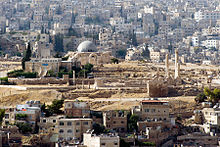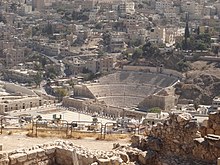
Back جبل القلعة Arabic Ciutadella d'Amman Catalan Zitadellenhügel von Amman German Citadelo de Amano EO Ciudadela de Amán Spanish Jabal al-Qal'a French מצודת עמאן HE Ammáni citadella Hungarian Benteng Amman ID Cittadella di Amman Italian
It has been suggested that Umayyad Palace, Temple of Hercules (Amman) and Ayyubid Watchtower (Amman) be merged into this article. (Discuss) Proposed since October 2024. |







31°57′17″N 35°56′03″E / 31.9547°N 35.9343°E The Amman Citadel (Arabic: جبل القلعة, romanized: Jabal Al-Qal'a) is an archeological site at the center of downtown Amman, the capital of Jordan. The L-shaped hill is one of the seven hills (jebal) that originally made up Amman.
The Citadel has a long history of occupation by many great civilizations.[1] Evidence of inhabitance since the Neolithic period has been found and the hill was fortified during the Bronze Age (1800 BCE). The hill became the capital of the Kingdom of Ammon, sometime after 1200 BCE. It later came under the sway of empires such as the Neo-Assyrian Empire (8th century BCE), Neo-Babylonian Empire (6th century BC), the Ptolemies, the Seleucids (3rd century BCE), Romans (1st century BCE), Byzantines (3rd century CE), and the Umayyads (7th century CE).[2] After the Umayyads, came a period of decline and for much of the time until 1878, the former city became an abandoned pile of ruins only sporadically used by Bedouins and seasonal farmers.[3][4][5] Despite this gap, the Citadel of Amman is considered to be among the world's oldest continuously inhabited places.[6]
Most of the structures still visible at the site are from the Roman, Byzantine, and Umayyad periods.[7] The major remains at the site are the Temple of Hercules, a Byzantine church, and the Umayyad Palace. The Jordan Archaeological Museum was built on the hill in 1951. Though the fortification walls enclose the heart of the site, the ancient periods of occupation covered large areas. Historic structures, tombs, arches, walls, and stairs have no modern borders, and therefore there is considerable archaeological potential at this site, as well as in surrounding lands, and throughout Amman. Archaeologists have been working at the site since the 1920s, including Italian, British, French, Spanish, and Jordanian led projects,[8] but a great part of the Citadel remains unexcavated.
- ^ Najjar, M. "Amman Citadel Temple of Hercules Excavations Preliminary Report." Syria 70 (1993). pp. 220-225.
- ^ "Citadel, Amman, Jordan". Retrieved 2008-05-31.
- ^ Chatty, Dawn (2010). Displacement and Dispossession in the Modern Middle East. The Contemporary Middle East (Book 5). Cambridge: Cambridge University Press. pp. 116–117. ISBN 9780521817929. Retrieved 25 December 2015.
The first permanent settlement in the southern Syrian provinces, Transjordan, appeared in Amman in 1878. Up until that point, there was no permanent settlement in Amman, the site of the ancient Roman city of Philadelphia. Some of the ancient buildings, such as the amphitheatre, provided occasional temporary shelter for the few farmers from the Ottoman capital of Salt who regularly cultivated patches of land in the area around Amman. This largely abandoned site was important, however, to Bedouin tribes for both its pasture and its good access to water.
- ^ Kassay, Ali (2011). Myriam Ababsa; Rami Farouk Daher (eds.). The Exclusion of Amman from Jordanian National Identity. Cahiers de l'Ifpo Nr. 6. Beirut: Presses de l'Ifpo. pp. 256–271. ISBN 9782351591826. Retrieved 25 December 2015.
The historic development of Amman from a ruin, abandoned for centuries, to the capital city of the Emirate of Transjordan, later the Hashemite Kingdom of Jordan. [...] a combination of natural disasters (believed to be earthquakes) and environmental degradation reduced it to a pile of ruins. The abandonment of Amman was compounded because the basin of its river became infested with malaria, causing the local population to keep at a safe distance. Amman was brought back to life in the late 19th century....
{{cite book}}:|work=ignored (help) - ^ Franciscan fathers (1978). Guide to Jordan. Jerusalem: Franciscan Printing Press. p. 64.
For a thousand years it has no history. In the 15th cent. it is referred to as a pile of ruins. In 1878 it was resettled with Circassians by Sultan Abdul Hamid and took on a new life.
- ^ French, Carole (19 December 2011). Jordan. Bradt Travel Guides. ISBN 9781841623986.
- ^ Bennett, C-M. (1978). "Excavations at the Citadel (El Qal'ah), Amman, Jordan". Levant. 10: 1–9. doi:10.1179/lev.1978.10.1.1.
- ^ Atiat, Taysir M. (2003). "An Egyptianizing Cult at the Citadel Hill (Jabal al-Qal'a) of Amman, Jordan". Levant. 35: 117–122. doi:10.1179/lev.2003.35.1.117. S2CID 162028926.